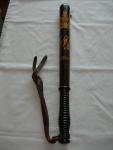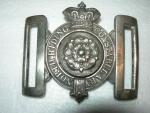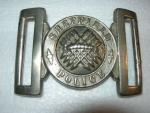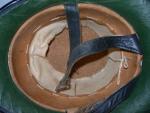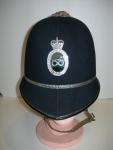-
Posts
13,225 -
Joined
-
Last visited
-
Days Won
22
Content Type
Profiles
Forums
Blogs
Gallery
Events
Store
Everything posted by Mervyn Mitton
-
Thought you might like to see the badges to go with your flashes. I believe the Special Forces unit was to guard the president and be in a state of readiness. Both were shown as being from 1980. Mervyn Mitton
-
Will - I did reply earlier, probably pressed return button and not add ! I am most impressed with this set - and as for the Defence of Mafeking, to an officer ! I'm sure you know the current value. You must never tell me your address - wheelchair or not - I may 'pay a visit.' Actually, I really would like to see your collection - I think even our major museums could be hard pressed to match some of your pieces. Mervyn
-
Just found this picture of a Staffordshire Constabulary truncheon - Queen Victoria crown and cypher. Prob. dates to about 1880. These were made for the firm of Parker Field, who were the armourers to the Metropolitan Police. These early County truncheons were not made in great numbers, so in this condition can be considered quite rare. I think we all know a lot more about Staffordshire, thanks to Brian. Mervyn
-
Thankyou Brian - I always wondered when they stopped putting the St. John's badge on the sleeve. I thought it was earlier. All UK police have to pass the first aid requirements and be re-tested every three years - it is amazing the number of people who collapse in the streets ( and usually when we were going back to the station for refreshments - selfish !) I used to carry a piece of strap to put in the mouth of epileptics - I got fed-up with having my pens bitten in half. I must tell you a funny story - and quite genuine. I was walking down a busy street in the East End - about mid-morning, when I saw a crowd standing on a corner - you always know what's happened - the crowd parts like the Red Sea - and there is a collective sigh - 'Thank G.. - here's a policeman.' Anyway to cut a long story short (not that I'm known for keeping it short!) a woman had collapsed with epilepsy,so I took all the necessary steps and called an ambulance - suddenly a man came-up and pushed me to one side - now, this was unusual since I was in full uniform. I challenged him and he said he was a qualified first aider - - so I told him I was too, but let him attend to her while I kept the crowd back. When I looked round he was 'interfering' with her and in front of about 100 bystanders!! I dragged him off , but had to let him go as I was on my own and the woman came first. All P.C.'s have stories like this - it would be nice to hear some of them. Mervyn
-
Dear Brian - I've never seen one of these patches before - will be worth a lot of money in 200 years !!! Actually, with the ever rising costs of antique items many police collectors specialise now in button hole enamel tacs, sleeve patches and of course badges; however, an old Victorian crown helmet plate can easily fetch ?200. The patches everone seems to collect are the American ones, but very few are original - the companies that make them for the police forces make thousands extra for collectors. I must say, you have built-up a fine Staffs. collection. Best wishes Mervyn
-
This rare commemorative plaque is interesting in that it shows the involvement of the South African Police during the U.D.I. period in the old Rhodesia. In Afrikaans, it shows the two years this unit was there and from the inscription they were based at Victoria Falls. Families do not part easily with items of this recent vintage and therefore, this can be considered an unusual item - it's also twice the size of most plaques. The person to tell us more of the history of SA involvement and this police unit will be Will Endley. Mervyn
-

Queen's South Africa
Mervyn Mitton replied to Avitas's topic in Great Britain: Orders, Gallantry, Campaign Medals
Erased medals are probably more common then you would think - we see quite a number brought into the shop - and as has been pointed out on another post the value is limited. However, broken-up they are valuable, as genuine bars and mounts are very hard to find. The reason why the medals are defaced is interesting - the families often don't want the medals but, are ashamed to sell something with their name. This was particularly so in the past when there seemed to be more family pride. I could post a board with twelve different QSA's - all to good units, but as prices are on labels would need Committee permission. Mervyn -
Although this is on an old truncheon - c1870 - it shows how the strap is fixed (sewn) to the top of the truncheon. We would always put our thumb through the strap and then wrap it around the hand - this prevents anyone pulling it from you. We were taught at training school not to hit on the head - but, rather on the shoulder and break their collarbone, if they are carrying a knife or club, the arm just drops. I always thought they looked better with both broken !! Mervyn
-
Sorry to come back - doing some research on a WW1 medal group, I discovered that the Royal Naval Air Service's first manned balloon in 1907 had the name Nilli Secundus- they had a machine gun in the small basket. There was also a NS2. Just one of those silly little bits of info. we all find ! Mervyn
-
A very nice helmet - the chromed badge is typical for that period. Mine used to have the E11R on separate pins - the Met. have always been mean and I suppose they thought it would be cheaper to change. I never understand all of these amalgamations in both the Services and the police - experience should have told them that the public like their own force or, regt.. These days the price of older helmets with good badges has rocketed. Mervyn
-
Most truncheons follow a similar style - the changeover period from 5 foot staves was in the middle to late 1700's. I have never seen an identified SAC truncheon and I agree with you - without markings it is difficult. The standard truncheon of that period was (approx)17" - this was probably ordered and made in S.A. Mervyn
-
For our Scottish police friends - a rare one from Glasgow. Dating from the (approx.) 1850's this small tipstaff was carried by an officer in the early Glasgow Detectives Office. Only about 5" inches long, it was intended to be held in a waistcoat pocket - when needed he would just take it out and hold at arm's length (the Tipstaff!!!). I have another version using a short malacca piece of cane - whereas this one is ebony. I will show two further pictures. Mervyn
-
I thought I should insert a collectable which is more in the moderate price range. Police have always worn a thick leather belt - one and a half inches deep - this was usually secured with a 'male & female' buckle. The alternative, was the 'S' shaped clasp, but that didn't show the Force. If the Chief Constable was willing to pay an extra two shillings (20P) he could have the Force name - this applied to truncheons (when they were heraldically painted), rattles,whistles. Extra wording on the old truncheons cost 1/6d (15p) This is a good example for Sheffield Police and dates to around 1910. Pricewise, about ?30. Mervyn
-
Herewith 4 pictures of the rare Beat M/cycle patrol helmet. Was only in use for a few years in the late '60's - they used the Velocette and with the high helmet, they were immediately called 'noddys' ! Police humour is very weird - I must tell you the story one day about when I was teaching beats to a new probationer !!! Although this is Queen's Crown - the naming is early - Staffordshire County. Unfortunately the enamel has been damaged - (Brian - an example for your recent post on damage to plates ) - this could be replaced or, a jeweller could probably match the enamel. This was the first time that helmets were properly re-inforced and the Met. followed this example for the rioting of the 70's and 80's. There is extra cork inside and the chin strap goes around the helmet to keep it on. Mervyn
-
Leigh - I for one, know very little about American police customs and their history - it would be good if some of our U.S. police members could give us info. Somewhere in the flat in Bournemouth is a wonderful record book for a precinct in New York - I think from the 1870's. It is what I think in the US is called the 'blotter' (?) - our equivalent of the daily info.book. I will get it sent over to SA so some pages can be shown. Mervyn





